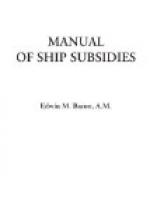Progress was checked appreciably by the war with Japan (1904-05). But the year after, the empire was active again in advancing her interests in the East, by systematically granting subsidies to steamship lines to various Asiatic points.[EV] By 1909 the tonnage had been brought to a total of 700,959 tons, approaching that of the year before the war. Of this total 443,243 was steam tonnage. The greater part of the steam fleet was foreign built, only 167 of the total, 898 steamers, being of Russian product. The largest number were built in England (341). Others were obtained from various European yards. More than ninety per cent were of iron and steel. Of the sailing-ships, ninety per cent were home product.[EW] In 1910 the total tonnage stood at 887,325 tons.[EX]
The mileage subsidies in 1910 were going principally to eleven steamship companies; the postal subventions mainly to four. Those receiving the mileage subsidies carry the mails and Government passengers free. The largest mileage subsidy goes to the Black Sea Navigation Company, the oldest and most important of the subsidized lines (founded in 1856, with Government aid).[EY] In addition to the subsidy the Government pays back the Suez Canal tolls. The Russian Volunteer Fleet stands second on the list of subsidy receivers. This is practically a Government affair. It was created in the war-time of 1877-78, by private subscription, as an auxiliary war fleet; and was reorganized for general service in 1892. The members of the board of managers are State nominees, and the officers and crews are regarded as employees of the crown.[EZ] The subsidy is fixed at six hundred thousand rubles ($309,999) a year; and the refunded Suez Canal tolls amount to another six hundred thousand rubles.[FA]
The mileage subsidies, given directly to foster shipping, increased rapidly from year to year after 1890, while the postal subventions, for mail carriage chiefly, remained practically constant.[FB]
FOOTNOTES:
[Footnote EQ: Meeker.]
[Footnote ER: U.S. Consul Smith, Moscow, in Con. Rept., no. 216, p. 149, Sept., 1898.]
[Footnote ES: U.S. Con. Gen. R.T. Greener, St. Petersburg, in U.S. Con. Rept., no. 236, p. 91, May, 1900.]
[Footnote ET: Report of The Merchant Marine Commission (U.S.), 1905, vol. II, p. 947.]
[Footnote EU: U.S. Commercial Agent R.T. Greener, Vladivostock, in U.S. Con. Repts., no. 265, p. 218, October, 1902.]
[Footnote EV: Same, no. 313, p. 140, October, 1906.]
[Footnote EW: Con. Gen. John H. Snodgrass, Moscow, in U.S. Con. Repts., no. 354, pp. 32-33, March, 1910.]
[Footnote EX: Lloyd’s Register, 1910-11.]
[Footnote EY: Con. Gen. Snodgrass, Con. Repts., no. 102, Oct., 1910.]
[Footnote EZ: Parl. papers: Report of com. of enquiry into Steamship Subsidies, 1901.]




